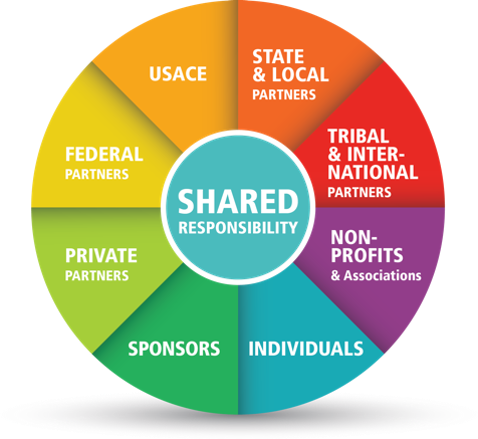Reducing flood risk
Reducing risk starts with an awareness and understanding of your own potential to face flooding from localized heavy rain to large-scale hurricanes.
While no entity or organization can eliminate flooding, this awareness at all levels of a community leads to shared responsibility. Individual, neighborhood, community, state and federal actions all add up to better solutions to reduce those risks.

Federal, state and local government entities share their responsibilities for flood risk management through programs and authorities. Many federal agencies, including the U.S. Army Corps of Engineers and the Federal Emergency Management Agency, oversee programs to promote flood risk management and assist states and local communities to reduce flood damage. The goal of the Corps’ Flood Risk Management mission is to save lives and reduce property damage from flooding.
Visit Partners in Shared Responsibility to learn about the federal role in flood risk management. flood risk management programs and resources available to states and communities across the country
Silver Jackets: partners in risk reduction
The Corps participates and promotes awareness of the Texas Silver Jackets program, a collaborative state-led interagency team that continuously works together to reduce flood risk in Texas. Visit https://silverjackets.nfrmp.us/State-Teams/Texas.
An updated approach to flood risk management
The government once used the term “flood control” for its efforts to protect people and property from flooding, but no one agency or set of actions can “control” or eliminate flooding. There are limits to both the ability to predict floods and the level of protection that the Corps, other agencies or human measures can provide.
The Corps focuses its policies, programs and expertise on reducing overall flood risk. This includes the appropriate use of structures such as dams, levees and floodwalls. It also promotes alternatives such as land acquisition, flood-proofing and landowners’ consideration of the purchase of flood insurance. Such alternatives reduce the risks to public safety, reduce long-term economic damages and improve the natural environment.
The Corps’ national Flood Risk Management Program is moving away from the heavily engineered solutions seen 50 years ago. It embraces a more comprehensive flood risk reduction strategy that emphasizes the importance of property owners, residents, communities and government understanding their roles and responsibilities in reducing overall flood risks before actual flooding occurs. For information, including an overview of flood risk management grants, visit Frequently Asked Questions.